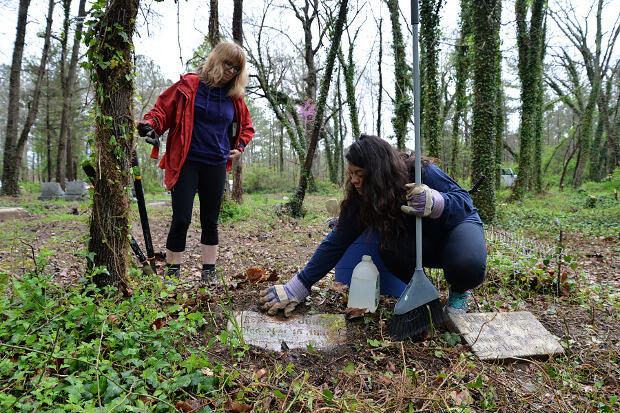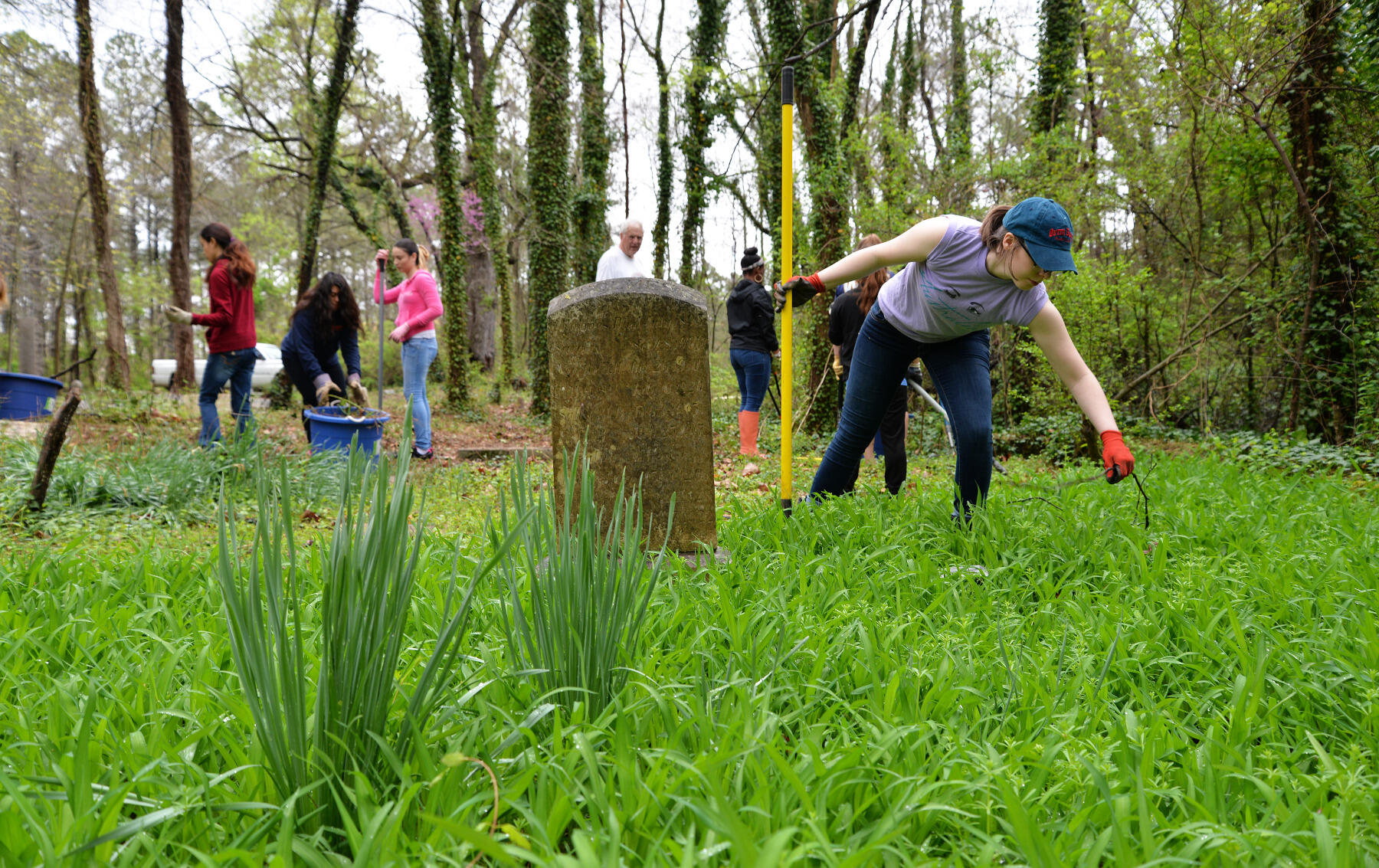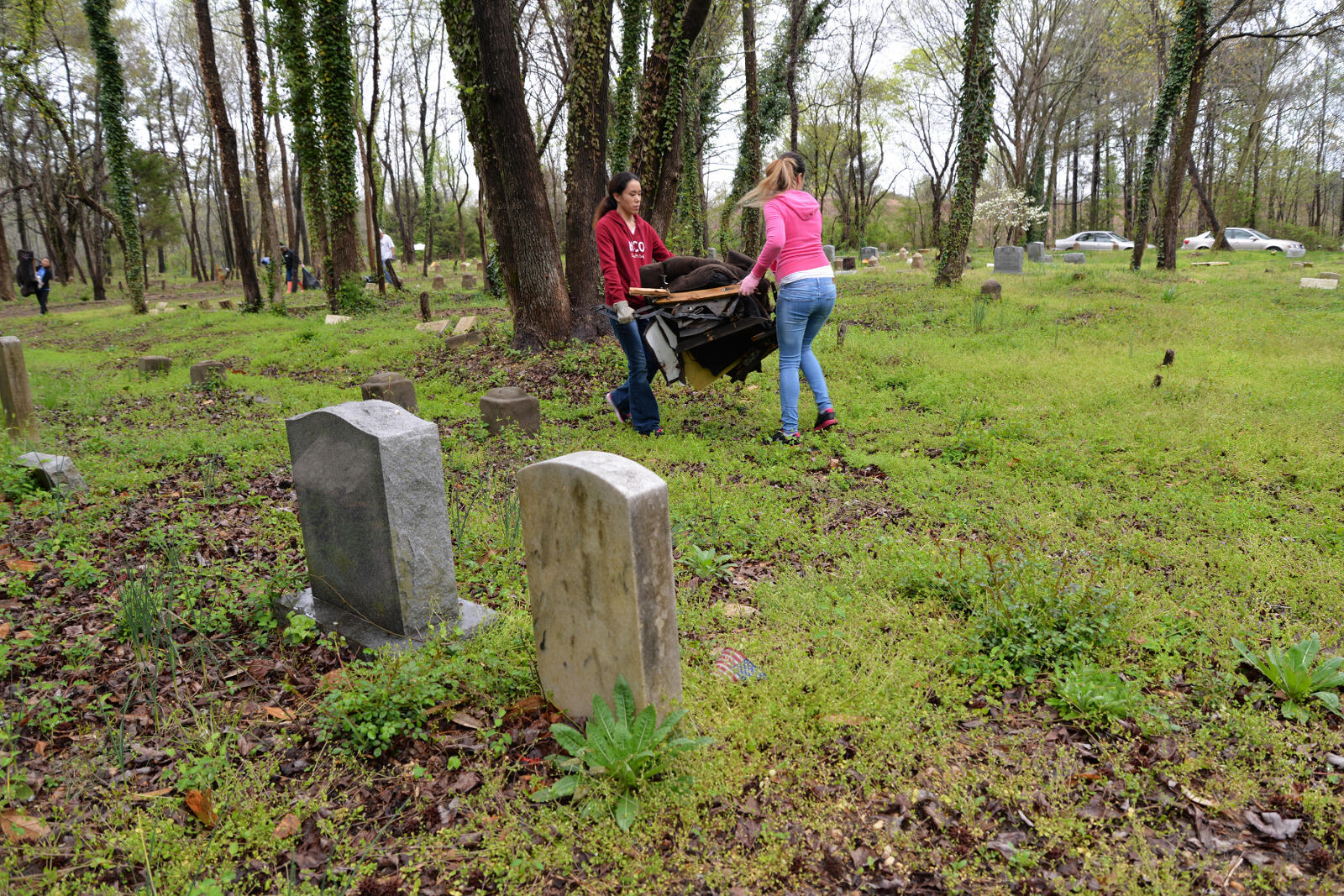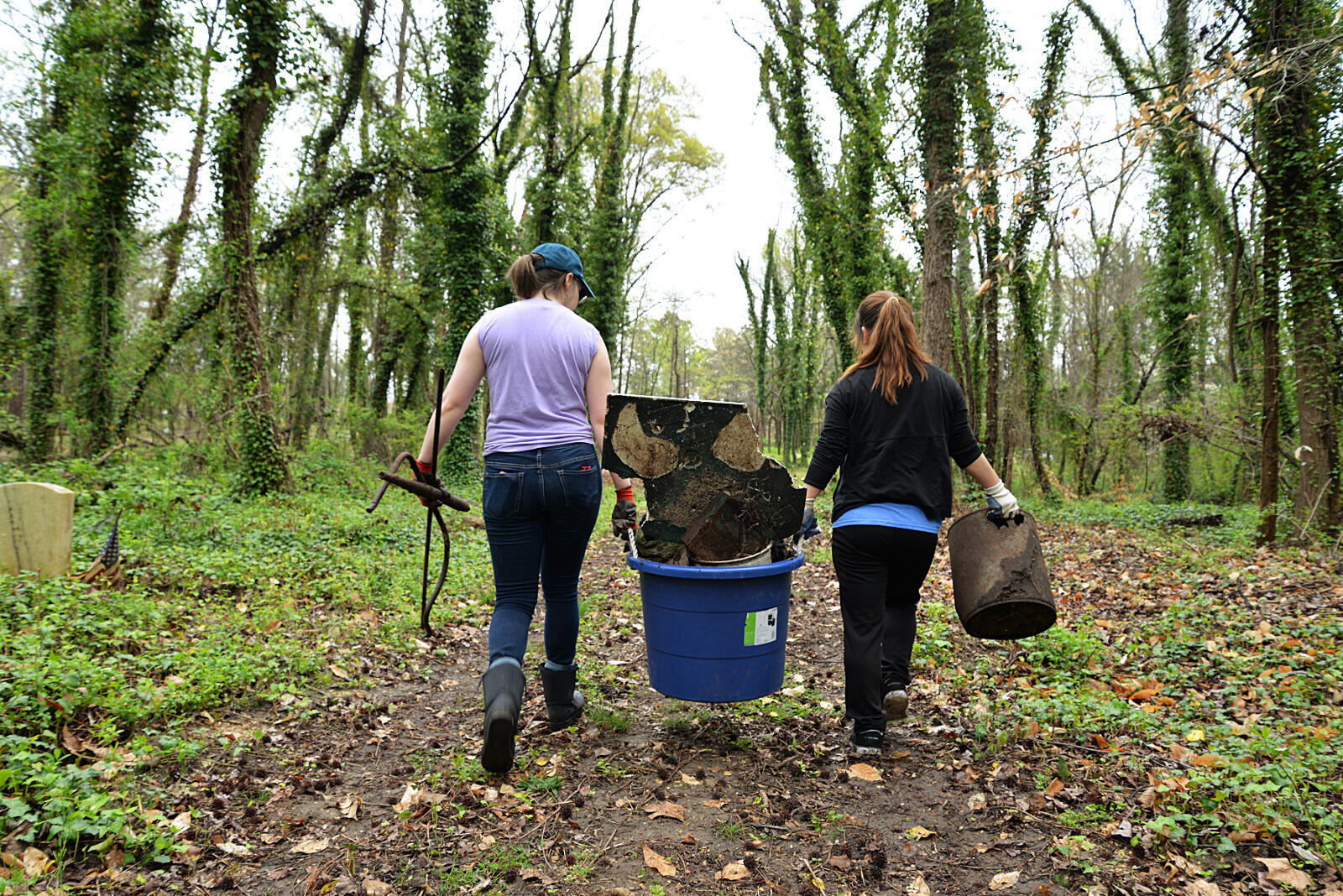
April 13, 2016
Students help clean up a long-neglected African-American cemetery — and uncover the past
Share this story
At the overgrown, long-neglected East End Cemetery, the Richmond burial site of untold thousands of African-Americans dating back to 1880, Virginia Commonwealth University professor Susan Bodnar-Deren, Ph.D., and her students were picking up trash and clearing brush and ivy from a grave plot on a recent Friday when Bodnar-Deren spotted something buried amid the mud and debris.
“Hey, I just found a headstone, guys,” called out Bodnar-Deren, an assistant professor in the Department of Sociology in the College of Humanities and Sciences.
Josselinne Robles, a senior international studies major, brought over a jug of water to wash away the grime, revealing a small headstone marking the plot as the final resting place of Rebecca Jones, who died in May 1931.
The discovery of Jones’ lost headstone is just one of many that have been part of the East End Cemetery Clean Up Project. Volunteers, including students at VCU, the University of Richmond and Virginia State University, have worked to clear the historic cemetery of brush, ivy and years of accumulated illegally dumped trash.
“Genealogy got me into this, and visiting cemeteries,” said John Shuck, volunteer coordinator of the project. “There’s a website called Find a Grave, and I started looking for cemeteries in Richmond to photograph and I came across [East End]. I saw what it looked like, and figured I’d clear a plot or two. Now, almost eight years later, I’m still at it. Just trying to get this place in order, from chaos.”
This semester, VCU students in Bodnar-Deren’s Sociology of Aging and the Life Course service-learning class are cleaning up the cemetery as a way to serve the community, but also to gather cemetery demography data recorded on the headstones.

“We are using the cemetery as a place to obtain data to examine things such as demographic transition, racial disparities in morbidity and mortality (when data is compared to those obtained in predominantly white or all white cemeteries), [and] examine concepts such as infant mortality, and gender and class differences in life expectancy,” Bodnar-Deren said.
The project’s other goal, she said, is to help reclaim the dignity of the individuals buried in East End Cemetery, and to underscore how the ways in which people are treated in life are often reflected in the ways they are treated in death.
“[The project is meant] to show students how institutional structures such as racism, exclusion and white supremacy not only affected individuals during life, it has been carried over into death as exemplified by the neglect and indifference to our city’s black cemeteries,” she said. “Right down the road from the East End and Evergreen cemeteries is Oakwood Cemetery which is being carefully cared for and tended, especially the interment sites of the wealthy and Confederate soldiers. This is a profound commentary on how we value certain people and not others.”
The cemetery cleanup project has had a strong effect on many of the students, particularly Latoya Williams, a senior sociology major, who has been told she has at least one family member buried somewhere in East End.
I was talking to some of my older relatives and they told me we might have family in the graveyard here.
“I was talking to some of my older relatives and they told me we might have family in the graveyard here,” Williams said. “But since they built the highway [nearby], a lot of them can’t find where the graves are located.”
At first, Williams said, the project was just community service. But after spending time in East End Cemetery, she began to feel closer to the people buried there.
“Once you’re out here it kind of removes that distance,” she said. “I mean, a lot of these people died so long ago, like in the 1880s. But you soon start to connect with them. It makes it feel a little closer than you might think.”
As part of the project, the students are recording names and birth and death dates from as many grave markers as they can find. To date, roughly 700 out of an estimated 13,000 have been recorded.
The grave marker information will be uploaded to the Find a Grave website, allowing family members to find the location of their relative or ancestor’s final resting place.
The data collected will allow the class to draw conclusions about the experiences of the African-American community, and can compare it to the experiences of the white community in Richmond during the same time period.
“We are aggregating all of the data into one large database [of grave marker information] so we’ll be able to see trends over time,” Bodnar-Deren said. “We can look at: How long were people living on average in the 1880s? Or the early 1900s? The average life expectancy at East End appears to be around 59, 60 years of age. It hovers around 75, 80 at Hollywood Cemetery. That tells you something about what life was like.”
Some of the VCU students are working on projects that link the records they uncover and find in the East End Cemetery with vital statistics to look at small trends in Richmond’s black community over the past century.
For example, the students recently cleaned up a section of the cemetery containing the gravesites of 65 to 75 babies, aged between newborns and around 2 years old, all between 1960 and 1964.

“A number of my students actually found headstones that had been buried deep. So obviously we record them, but then they’re going to be linking them with vital statistics,” Bodnar-Deren said. “And then we’ll try to determine what could possibly have gone on in the African-American community during that period of time.”
Angela Nam, a senior interdisciplinary science major, was among the students who helped clean up and document the baby site.
“We had to dig out all these [cemetery plots] and try to uncover the stones, and so I thought that was interesting to see who was buried there and to find out when they passed away. I saw a lot of babies, which was saddening but also really interesting,” she said.
Other students are doing more artistically inclined projects inspired by their time in East End and the data they have collected.
“Coming out here, it’s definitely a sacred space,” Bodnar-Deren said. “One student, his project is going to be to create a sort of minidocumentary. Another is actually doing a series of poems and spoken-word pieces to honor those who have been passed and been interred here.”
Approximately 35 students in Bodnar-Deren’s class have been taking part in the cleanup at the cemetery. Another six or so students have been doing a different service-learning project, working with young people in the Oak Grove-Bellemeade Leadership group to make a short video documentary that celebrates the Southside community of Oak Grove-Bellemeade.
“While it is what many would say is a ‘low-opportunity neighborhood,’ the people who live there have really come together to build a strong community,” Bodnar-Deren said. “The neighborhood often gets a bad rap and is stigmatized and the kids there want to correct that, to empower each other, their community and the rest of the city.”
So the VCU students have been working with the VCU ALT LAB and the community’s youth to produce digital interviews with community leaders who are empowering others and giving voice to the neighborhood.
I feel like I’m contributing to the community, but also uncovering the past.
“The goals of the project have been to illustrate to VCU students the life course concepts such as ‘linked lives,’ cumulative advantage/disadvantage over the life course, the salience of social support and kinship,” Bodnar-Deren said. “For both the youth and VCU students the exercises are multimodal, including planning a project, writing out long-form narratives, storyboarding and then capturing the video, pictures, editing and presentation.”
As for the students working on the cemetery cleanup project, quite a lot remains to be done, but the students say they are far from discouraged.
“We’re just trying to help to fix up the graveyard, picking up trash, picking up branches. Just trying to make it look a little nicer,” said Alexis Mejias, a junior sociology major. “It feels really good. I feel like I’m helping out.”
Victoria Mills, a senior interdisciplinary science major, added, “I feel like I’m contributing to the community, but also uncovering the past.”

Subscribe for free to the weekly VCU News email newsletter at http://newsletter.news.vcu.edu/ and receive a selection of stories, videos, photos, news clips and event listings in your inbox every Thursday.
Subscribe to VCU News
Subscribe to VCU News at newsletter.vcu.edu and receive a selection of stories, videos, photos, news clips and event listings in your inbox.











